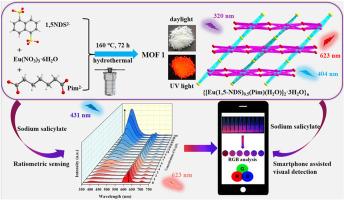基于双配体Eu(III)-MOF的智能手机辅助比例荧光检测水杨酸钠
IF 6
2区 化学
Q1 CHEMISTRY, ANALYTICAL
引用次数: 0
摘要
背景水杨酸钠(SS)是阿司匹林的衍生物,具有重要的抗炎作用,也是食品中的防腐剂。然而,过量摄入SS会对人体健康造成威胁。因此,准确、便携的SS检测对人类健康和食品安全至关重要。结果合成了一种新的双配体Eu(III)金属有机骨架(MOF),并将其作为比例荧光传感器用于SS的灵敏检测,即{[Eu(1,5- nds)0.5(Pim)(H2O)]2·3H2O}n (MOF 1) (1,5- nds2 - = 1,5-萘二磺酸盐,Pim2- = pimelate)。在该结构中,Eu(III)中心通过磺酸基和羧基桥接形成一维(1D) [Eu(SO3)(COO)2]n链,并通过Pim2-和1,5- nds2 -进一步连接,形成具有三节(4,4,6)连接拓扑结构的三维框架。由于内部滤光效应(IFE)和光致电子转移(PET), SS在431 nm处的蓝色发射增强,而Eu(III)在623 nm处的红色发射被猝灭,从而产生比例荧光响应。I431/I623与SS浓度在1 ~ 60 μM范围内呈良好的线性关系,检出限为51.74 nM。值得注意的是,建立了智能手机辅助RGB法对SS进行定量检测。意义所建立的比例荧光法和RGB法可用于实际蜂蜜样品中SS的检测。本工作有望建立一种方便可靠的SS检测策略。本文章由计算机程序翻译,如有差异,请以英文原文为准。

Smartphone-assisted ratiometric fluorescence detection of sodium salicylate based on a dual-ligand Eu(III)-MOF
Background
Sodium salicylate (SS) is a derivative of aspirin, which plays important roles for anti-inflammatory, it is also a preservative used in food. However, excessive intake of SS will pose a threat to human health. Therefore, accurate and portable detection of SS is crucial for human health and food safety.Results
Herein, a new dual-ligand Eu(III) metal-organic framework (MOF) was synthesized and applied as ratiometric fluorescence sensor for sensitive detection of SS, namely, {[Eu(1,5-NDS)0.5(Pim)(H2O)]2·3H2O}n (MOF 1) (1,5-NDS2- = 1,5-naphthalenedisulfonate, Pim2- = pimelate). In the structure, the Eu(III) centers are bridged by sulfonic and carboxylic groups to form the one-dimensional (1D) [Eu(SO3)(COO)2]n chains, which are further connected by Pim2- and 1,5-NDS2- to generate a 3D framework with a trinodal (4,4,6)-connected topology. Due to the inner filter effect (IFE) and photoinduced electron transfer (PET), the blue emission of SS at 431 nm is enchanced while the red emission of Eu(III) at 623 nm is quenched after addition of SS, thus resulting in the ratiometric fluorescence response. A good linear relationship between I431/I623 with the SS concentrations from 1 to 60 μM can be obtained with the detection limits of 51.74 nM. Remarkably, the smartphone-assisted RGB method was developed for quantitative detection of SS.Significance
The established ratiometric fluorescence and RGB methods can be applied to detect SS in real honey samples. This work is expected to establish an convenient and reliable strategy for SS detection.求助全文
通过发布文献求助,成功后即可免费获取论文全文。
去求助
来源期刊

Analytica Chimica Acta
化学-分析化学
CiteScore
10.40
自引率
6.50%
发文量
1081
审稿时长
38 days
期刊介绍:
Analytica Chimica Acta has an open access mirror journal Analytica Chimica Acta: X, sharing the same aims and scope, editorial team, submission system and rigorous peer review.
Analytica Chimica Acta provides a forum for the rapid publication of original research, and critical, comprehensive reviews dealing with all aspects of fundamental and applied modern analytical chemistry. The journal welcomes the submission of research papers which report studies concerning the development of new and significant analytical methodologies. In determining the suitability of submitted articles for publication, particular scrutiny will be placed on the degree of novelty and impact of the research and the extent to which it adds to the existing body of knowledge in analytical chemistry.
 求助内容:
求助内容: 应助结果提醒方式:
应助结果提醒方式:


